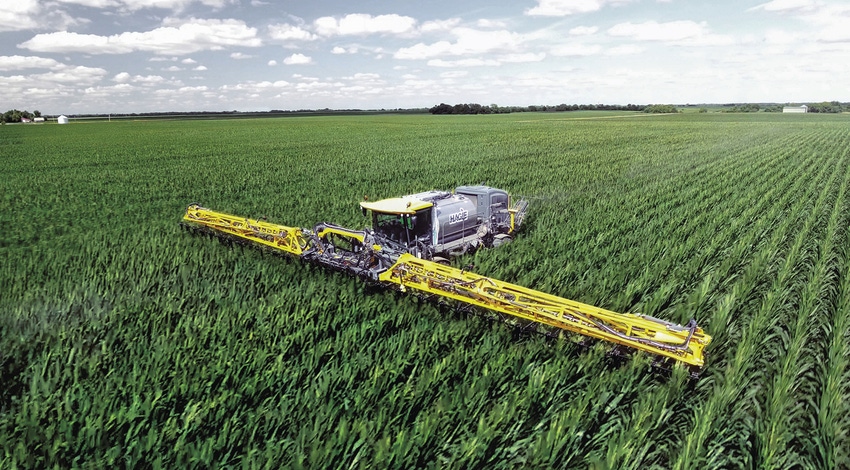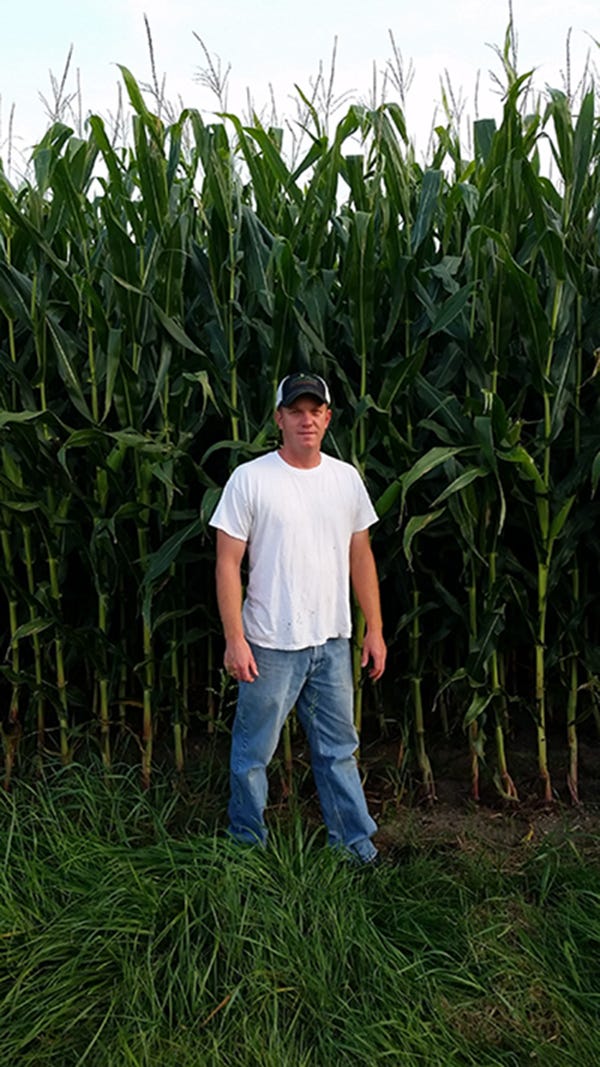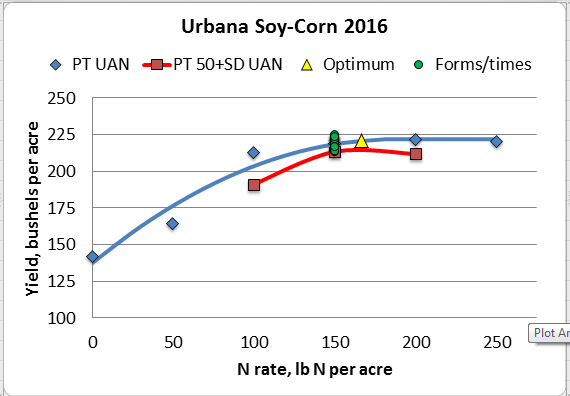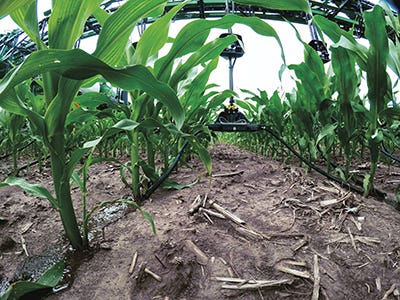January 7, 2017

Think different
In some years, when you have heavy rains in June after late-May sidedress N, a July application before tasseling can boost yields.
Unfortunately, the results aren't always that clear, nor are conditions always so cooperative to this particular strategy or any other.
While searching for strategies that will produce greater yield while reducing losses to leaching and de-nitrification, they have each come to similar conclusions. "The watchword is inconsistency," says Emerson Nafziger, Crop Production extension specialist, University of Illinois. "We put the same rate of nitrogen on in about 20 different ways in one of our current projects. Across 10 site years, we see the highest- and lowest-yielding treatments moving around a lot, sometimes even trading places from one site to another.”
No one strategy is ideal for every acre, every season.
---------
The evidence from 2015 couldn't be clearer.

"Our farm average, near Waldro, Mich., was 205 bushels per acre, but June was amazingly dry, which I think reduced the rounds on ears from last year," says Aaron Smith. "However, from early July on through harvest we were plenty wet."
The conditions couldn't have been better for a delayed N response either year. In 2015, their delayed application made up for N lost in May and June, and in 2016 more than adequate moisture followed the application. Unfortunately, the results aren't always that clear, nor are conditions always so cooperative to this particular strategy or any other.
The inconsistencies of N
Jim Camberato, extension soil fertility specialist, Purdue University, and Emerson Nafziger, Crop Production extension specialist, University of Illinois, have spent much of their careers studying nitrogen utilization. While searching for strategies that will produce greater yield while reducing losses to leaching and de-nitrification, they have each come to similar conclusions.
"The watchword is inconsistency," says Nafziger. "We put the same rate of nitrogen on in about 20 different ways in one of our current projects. Across 10 site years, we see the highest- and lowest-yielding treatments moving around a lot, sometimes even trading places from one site to another. At Urbana in 2016, they all yielded nearly the same. This sort of inconsistency among years and sites means that however nitrogen is currently being applied, at least in most fields, it is probably working pretty well."
"Nitrogen is a riddle wrapped in mystery inside an enigma," says Camberato, paraphrasing Winston Churchill's description of Russia. "I've been doing this a long time, and I don't think anyone understands nitrogen well enough to accurately predict what will happen."
As an example, Nafziger points to use of inhibitors. "It turned wet in May of 2015, but not in May of 2016," he says. "Inhibitors were helpful in places in 2015, but with very little N loss, they didn't return their cost in 2016 even if they worked as advertised."
N
N loss or root injury
While nitrogen deficiencies were a problem that year, Nafziger questions the cause. "I think a lot of what we assume being nitrogen loss may, in some cases, be crop root injury that limits the ability of roots to take up nitrogen," he says, noting that such areas may recover on their own...or not. Either way, assuming more N is needed may simply lead to greater losses to the wallet and the environment.
"Nitrogen losses accelerate when you go past the amount the crop needs," he says. "You may get twice the loss for every pound applied above the recommended rate than at or below it."

"Over the course of trials since 2007, we've had as much problem with dry weather late in the season as wet weather early," he says. "Moisture after a delayed application is the issue. If you put it out and it doesn't get used in one season, it is unlikely to carry over to the next."
He points to the impact of 2012, where N went unused due to the drought. In 2013 N moved into the waterways, leading to a dramatically larger "dead zone" in the Gulf of Mexico later that year.
Split application strategy
Jim Schwartz, regional agronomy manager, 360 Yield Center, is also quick to point to 2012, but as an excellent reason for a split-application strategy. "If a grower had split his applications, as he got deeper into the season, he could see it wasn't the year to reach a 220-bushel yield goal and pull back," he says. "In a way, the same was true in 2016 with more mineralization than I've seen in my 32 years as an agronomist. If a grower doing delayed applications took soil samples in June and saw exceptional mineralization, he didn't have to apply additional nitrogen."
Schwartz reports that high mineralization with almost no response from supplemental N was the norm in 2016 across the central Corn Belt from Ohio to central Iowa, just as losses were the norm in 2015. That experience, he suggests, was the opposite of the northern Corn Belt from Wisconsin through Minnesota and northern Iowa. In any case, he argues that the take-home is not that it is necessary to apply a certain amount of N in season, rather that the longer you wait, the more information you can gather before making an application. Even though mineralization reduced the need for delayed application with his company's 360 Y-Drops, he argues that it was a good year for the product and its customers.
"By delaying applications, they had the option to reduce input costs by $20 to $30 per acre," he says.
Like Nafziger, Camberato points to the potential difficulty and expense of making delayed applications as a negative. However, he suggests the mysteries of nitrogen raise even more questions. Soil types, it is acknowledged, are key to mineralization, leaching and other nitrogen issues. In general, high organic matter, heavier soils should produce more mineralization and yield better than sandy soils given similar weather...except when they don't.
"We have trials in northern Indiana on clay loam soils with four to five percent organic matter across the road from loamy sand soils with one-and-a-half percent organic matter," says Camberato. "For the past three years, the sandy soil has out yielded the clay loam soils with similar nitrogen applications and produced higher yields two years with no added nitrogen."
Mystery of N and soils
Camberato's takeaway is that with good rainfall, the sandy soils mineralized more nitrogen than the high organic matter clay loam.
Nafziger adds to the mystery, pointing out that research remains very unclear about the value of measuring available nitrogen in the soil. Schwartz agrees that while we can test for ammonia and nitrates, it remains impossible to define a target number, but argues that one isn't necessary.
"The point is do we have a lot, a little or something in between," he says. "There is art that goes with the science. Intuitively, we know we had very little leaching and lots of mineralization this year and can cut back without impacting yield."
The problem, Nafziger suggests, is a question of what is "a little"? "People might think that a soil sample in head-high corn with only 10 parts per million of nitrate can't be enough," relates Nafziger. "In fact, we have had soils with no more than five parts per million in the top foot in late June that still yield 240 bushels of corn." Remember that the crop might have as much as 150 lbs. of N or more in the plants already, and that uptake rates slow considerably after pollination.
Noting that the amount of nitrate in the soil decreases daily as the crop takes up N in the weeks before pollination, he argues that if the crop is well supplied up to pollination, there is no justification to apply more N. "In soils with more than 2.5% organic matter, mineralization by itself can almost take care of need for N after pollination. The soil also has the ability to retain N applied earlier and provide it to the crop."
Schwartz is quick to admit that more research is needed if the nitrogen enigma is to be resolved, and it needs to be resolved. "We've learned more in the past three years than ever before," he says. "Our overall goal has to be to mitigate nitrogen in the groundwater without sacrificing yield. That is an important goal for growers to reach."
About the Author(s)
You May Also Like




